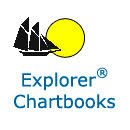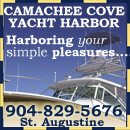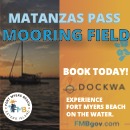Weather Resources for Cruisers by Greg Allard
Weather Resources for Cruisers
By Greg Allard
Cruisers- especially those looking to travel longer distances, soon learn Rule One of cruising: It’s All About the Weather.
This article discusses the weather sources we have used on the east coast of the U.S., in the Caribbean and the Bahamas, and a good bit of this information also applies to the west coast of the U.S. and Canada; some of the sources provide national or worldwide information.

Understanding cloud formation is critical to understanding pending weather. There are numerous sources which explain the many different clouds and what they portend. In this photo, taken off the west coast of the Berry Islands, these two upward moving cloud columns may develop into something nasty.
We don’t pretend that this article is exhaustive: experienced cruisers will undoubtedly have different sources or methods they rely upon, but these are the ones which have worked for us.
Remember: you are ultimately responsible for the decisions you make about the weather. By its very nature, weather forecasting is an inexact science, and the best professional forecasters and weather sites are, on occasion, just plain wrong. Wind forecasting is especially problematic: marine wind speeds are often different from what is forecast: sometimes less, and often – more. This article will outline multiple sources of weather information, but as captain of your boat, only you can use that information, and your own judgment, to make the decision to go, or not to go.
See Rule Two, at the end of this article.

This shelf cloud, coming across Highbourne Cay Marina in the Exumas, means: “Don’t leave the marina.”
If you have internet access:
Marv Market’s Weather Service: Marv provides a daily e-mail update which draws upon Buoy Weather reports (see below). He covers multiple locations throughout the Bahamas, the Caribbean and the eastern and Gulf coastal U.S. from Texas to Maine. As an example, if you are travelling from Miami to Bimini, there will be a specific report for that route. His reports include projected wave heights and their period (time between waves, in seconds), wind speed and direction, all shown in a seven day projection. The graphic reports are exceptionally easy to use.
Marv also provides extremely valuable Tropical Updates, whenever there is a potential severe weather system which might affect the U.S. east coast, the Caribbean or the Bahamas. His analysis is some of the best we have seen. He also appears to give alerts at least a couple of days before anyone else. The Tropical Updates come by e-mail; he sends them only when necessary.
If you want to be added to his daily mailing, send him an e-mail request at: marvboater1@aol.com. He asks for a voluntary donation while you use his service.
The convenience of having Marv’s comprehensive package of reports in your mail each morning cannot be overstated.

A fast moving storm, approaching from the SE, at Staniel Cay in the Exumas. The dark area which reaches down to the water (just to the right of the island) is heavy rain.
Buoy Weather: In my view, one of the singular best commercial internet weather sites. Annual fee: up to $79.95. Worldwide coverage. www.buoyweather.com.webloc
As mentioned above, one of Marv Market’s principal sources of information is an arrangement he has with Buoy Weather. You can access the Buoy Weather site for free, but that will only give you projections for two days. Membership gives you wind and wave forecasts for seven days, plus a number of multiple additional features, including the ability to select a specific location for your weather reports. It’s worth looking at the site, just to see what is offered.
Both Marv Market’s Weather Service, and Buoy Weather have additional links and significant features which make them individually valuable. We subscribe to both. We cruise about six months each year; having such valuable weather information available for a modest cost is an easy decision.
Passageweather: passageweather.com.webloc
This site always makes our short list for reliable forecasts. A bit more difficult to navigate than some, but we consult it daily.
Other sites you may find helpful include:
1) WINDYTY : windytv.com
Worth exploring, if just for the neat graphics!
2) LEE CHESNEAU’S information-packed weather site:
www.chesneaumarineweath#152F3A8
Lee Chesneau is a first-class weather instructor, and his website is rich with content and helpful links.
3) INTELLICAST: www.intellicast.com.webloc
4) OCENS: A number of serious offshore cruisers use this regularly for both weather and satellite based communications. www.ocens.com.webloc
5) The NOAA National Weather Service (NWS) sites, are primary sources for coastal and offshore information. They also include hurricane data. Here are two links to get you started:
www.nws.noaa.gov/om/mar#1C97533
www.nws.noaa.gov/om/mar#1C975E3
6) Crown Weather: crownweather.com/.webloc
Excellent site with superb graphics.
National Data Buoy Center (NBDC): www.ndbc.noaa.gov.webloc
This site is operated by NOAA, and rather than give projections or estimates of wind and wave conditions, the advantage is that it reports actual conditions in almost real time, – at hundreds of locations, both buoy and coastal-based. For instance, if you access the Settlement Point (West End, Bahamas) report, you can see wind speed and direction no more than an hour ago. It’s valuable to know what the conditions actually are, rather than what they are supposed to be. (The Settlement Point site does not report on wave heights, but many of the various NDBC locations on the east and west coasts of the U.S. do.)
At times, some of the NBDC stations are “down” (not operating), or the sites are reporting only limited information.
Each station’s report includes a link to the full National Weather Service Marine reports. You can set up your own file of preferred NDBC locations to make access easier.
Another feature of the NBDC worth knowing about is the “Dial-A-Buoy” service. Information about it can be found using the link above. Using your cell phone (or sat phone) you call the NDBC and enter the number-identifier of the buoy you want. You will then hear a voice report of the current conditions at that buoy, and in many instances, you can also receive the voice report of the NWS forecast. It helps if you have identified the buoy ID numbers ahead of time on the internet, as obtaining them on the phone connection is cumbersome.
Wunderground: This is a general purpose weather site, not primarily marine, but it contains an great deal of good information, including links to the U.S. based radar sites.

This photo from NOAA shows a classic “anvil” cloud, one of the most important clouds for mariners to recognize. They are often a sign of thunderstorms.
As an example, here is the link to the Tampa, FL radar, which covers all of SE United States and includes the Florida Straits. www.wunderground.com/.webloc (Zoom the image out, to see full radar and wind coverages.)
While U.S. based radar only extends into the Bahamas as far as the center of Grand Bahama island, and the west side of Andros, U.S. radar is extremely helpful in planning a crossing of the Florida Straits (Gulf Stream).
The Wunderground radar link (above) also has sub-links to view lightening strikes and storms, as well as satellite views, which show storms and strikes outside of the U.S. radar area. (There is no weather radar in the Bahamas.)
The Wunderground site can also link you to land based forecasts which are helpful for projections of rain or thunderstorms. For instance, here is the link to the extensive Wunderground information for Great Harbour in The Berry Islands, Bahamas: www.wunderground.com/ 3.webloc
(Note on Bahamas internet access: Bahamian cruisers will find that access to the internet is very good in most places. Just as in the U.S., almost all marinas have wi-fi – at some it is free, others impose a charge. Or, if you are anchored or moored in the Bahamas near a BTC (Bahamian Telecommunications) tower – which are in-place on almost all inhabited islands – you will be able to access the internet, provided you have made plans with either your own carrier, or the Bahamian Telecommunications Company (BTC.). The BTC towers often offer coverage up to ten miles from shore. Some of the really remote Bahamian islands have no access, and the Exuma Land and Sea Park has internet only if you are sitting next to the office at the main headquarters at Warderick Wells.)
Non-Internet accessed Weather Sources:
VHF Radio Weather Channels:
With multiple internet ways to obtain weather, the National Weather Service reports on VHF Radio are often overlooked. They are free, current and as reliable as anything else. Depending upon the condition of your equipment and connections, and height of your antenna, their reports are often available a considerable distance offshore, and occasionally in some parts of the Bahamas.
Sirius Marine XM Satellite Weather (WxWorx) : www.siriusxm.com/.webloc
For cruising everywhere along both U.S. coasts, significant portions of southern Canada (but not Alaska), the Bahamas and some portions of the Caribbean (including Cuba), we’ve found that the single best way of obtaining weather when the internet is not available is through Sirius Marine Weather (WxWorx). Just like Sirius radio, the information is provided by satellite.

This drawing, from the Sirius site, approximates the area of coverage of Sirius XM Marine weather. Sirius notes that: “Satellite signal strength at border regions may be limited.”
Sirius shows wave heights and direction, wave period, wind speed and direction, radar (again, U.S. based), lightening strikes, movement of fronts, buoy data, storm paths, tropical storm warnings, satellite views (including lightening strikes outside the reach of U.S. radar) and NWS forecasts for coastal and offshore.

A screen shot of Sirius Marine Weather (WxWorx) from our shipboard computer in April of 2015. The lower part of Florida is on the left of the screen, and some of the Bahamian islands are in the center. The bright yellow, green and (some red) areas on the left side of the screen are all rain, picked up by the U.S. based radar. There are lightening strikes shown in the red areas on the lower left. The real time version of this screen showed the storm moving directly east. Note that the U.S. based radar only goes as far as the west end of Grand Bahama island (top of the screen) and the west side of Andros, the large grey island in the middle of the screen. All of the lightening strikes from the center to the right side of the screen have been picked up by satellite, not radar, and provided by Sirius via satellite. So while there are no radar returns showing the heavy rains from the center of the screen over to the right, the strong number of lightening strikes surely means that there is bad weather there, and likely to be heavy rains and wind. The different colors of the lightening bolts indicate the amount of time since the recorded strike: white means the strike was less than 5 minutes ago, yellow is 5-10 minutes old, and orange occurred 10-15 minutes ago.
The strength of Sirius is that you have access to the weather 24-7, without needing an internet connection. It has helped us plan for multiple open-water crossings.
A negative: the wind and wave forecasts are projected only two days out. Access to the NWS forecasts does make up, to some extent, for that deficiency.
For a stand-alone Sirius marine application you need a WxWorx “black box” and a small mushroom antenna, connected to either an onboard Windows computer or laptop. The box, from WxWorx, costs $830, however you may be able to find a perfectly serviceable used one on E-Bay. We secured a used box, and found that Sirius offers free software updates for all of their older WxWorx receivers.
We’ve had two boats equipped with Sirius; on both we’ve used a stand-alone box, connected to either a Windows desktop or a laptop. The service has been excellent and the package with the most features (recommended) is the “Master Mariner” at $49.95 a month.
Some chartplotters can also receive the Sirius data, using their own proprietary black box or related equipment. We’ve seen Sirius in use on several chartplotters, and sometimes the data presented was in a different format, less detailed and a bit more difficult to access than what we receive with our stand- alone Sirius system. This is based on several observations; some cruisers may have a different experience, depending on their hardware. This statement is from the Sirius site:
“The availability and display of service features….varies by hardware provider.”
Cruisers may find that the access to Sirius WxWorx through a chartplotter will be more than adequate, and that it is more cost-effective to connect it to their existing chartplotter..
If you want to see if you can access Sirius XM weather on your chartplotter, start by consulting your owner’s manual, or contacting the manufacturer of your device. You could also call Sirius, but do not call the regular toll-free number which is used to subscribe to the service. They are nice order-takers, but know nothing about the technical side. Instead, call one of the technical people at Sirius, whose contact information is on their website.
Sirius has a good feature which allows you to suspend the service for months at a time when you are not cruising.
Once you install the system, spending less than $2.00 a day for this kind of weather access is smart choice especially if you are doing open water passages.
Ship’s Radar: Some cruisers don’t recognize the value of the vessel’s radar as a weather monitoring tool. When it is set on longer ranges, your radar will pick up fast moving rain storms, and you can plot their direction.
Other Non Internet Options: There are a number of other sophisticated – and sometimes complex – ways of collecting weather information. They include using a “short wave” radio receiver (less than $200) to receive scheduled reports; weather reports and “GRIB” files can also be downloaded from various sources through an SSB or a SAT phone. A portable “short wave” type radio receiver is a reasonable way to receive SSB forecasts, without the chore of installing and learning how to use a full featured SSB. Just be sure that the portable short wave radio you purchase has the required frequencies to access the reports you want. (See below).
Weather Services: Paid Professional Forecasting and Routing Advisors:
Offshore, SSB and Sat Phones (with a fax) can be used to obtain voice or printed forecasts from a professional weather routing provider such as Chris Parker (search “Chris Parker Weather Service”) who offers customized interpretation of weather data tailored to your specific route. (Parker’s services can also be accessed by e-mail, internet or cell phone where you have a connection.)
The use of a weather routing service may be more important if you are cruising to remote places, travelling offshore for days at a time. Parker focuses primarily on the Bahamas, the western Atlantic (including Bermuda) and the Caribbean.
Another recognized weather service is that run by Bob Jones, called Ocean Marine Navigation, Inc. (OMNI) www.oceanmarinenav.com.webloc
OMNI offers worldwide coverage, which you can access using multiple methods. Jones has provided services for the two Nordhavn cross-Atlantic Rallies and for multiple FUBAR rallies on the west coast of the U.S./Mexico. His service is well-regarded by experienced offshore and trans-ocean cruisers.
SUMMARY: Virtually all of the information and data available on any packaged weather site or service is available often for free, on the internet. The real value of dedicated sites (such as Buoy Weather, Passageweather or Marv’s Reports) is that they pull together in one place multiple sources of the information you need, and present it in an easy to digest, integrated format. Sirius does the same thing, but makes it available via satellite. Weather Routing Services go a good step further, and add professional interpretation to the data.
A Note on Learning about Bahamian and Caribbean Weather Patterns:
We would not think of cruising Bahamian waters without the most current editions of the Explorer Charts, which have separate chartbooks for Near Bahamas, Far Bahamas, and the Exumas. Not only do they have, in our experience, the most reliable and accurate charting details, but they also contain a huge amount of usable information about local anchorages, facilities, etc.
The current editions of the “Near Bahamas” and “Exumas” Explorer books include an excellent full page discussion of Bahamian weather, fronts, hurricanes, analysis of changing patterns by season, and other weather resources, written by Chris Parker and Frank Ready. All three books have a list of weather stations, frequencies and the times at which you can receive weather reports on a portable “short wave” type radio.
For Bahamian and Caribbean cruisers, another superb book is Bruce Van Sant’s: A Gentleman’s Guide to Passages South, which contains an excellent discussion of weather patterns from Florida, through the Bahamas, and into the Caribbean.
As was said above, as captain of your boat only you can use information about the weather, coupled with your own judgment, to make an intelligent decision. Which brings us to the second, simple rule of marine weather forecasting.
Rule Two: If you think the weather is questionable, and you are not sure if you should go, then don’t go.
- Greg Allard has held a U.S. Coast Guard Master’s License for over 25 years. He has instructed U.S. Coast Guard and Navy crews, and the crews of foreign military partners of the U.S., in the operation of new coastal and offshore patrol boats delivered to them. He and his wife Barbara cruise aboard their 61’ Tollycraft “Meander” about six months a year. They have voyaged extensively along the U.S. east coast, the Bahamas, Caribbean, and most recently cruised aboard a friends’ boat in the Swedish archipelago on the Baltic Sea. He has no financial or other interest in any of the sites or companies mentioned.
- Copyright – Greg Allard, 2016


















Be the first to comment!